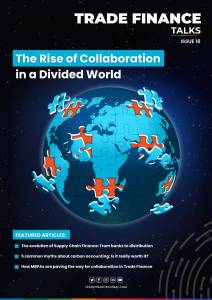Estimated reading time: 8 minutes
Cross-border payments can play a special role for people and businesses around the world. They allow us to send money to our loved ones, book a holiday of a lifetime, or start a business in another country.
However, cross-border payments have traditionally been slow, expensive, and opaque. For individuals, this could mean paying high fees and waiting days or even weeks for their money to arrive.
For a business, it could mean losing out on an opportunity to grow and expand into a new market. And for the global economy, it can drag on trade and investment.
For banks, it can mean experiencing significant delays and fees on cross-border payments.
While the banking system at face value can be seen as responsible for these inefficiencies, it is not entirely its fault. Banks face significant regulatory and compliance hurdles that can hinder their ability to create smoother processes.
The challenges of cross-border payments
Though we believe that cross-border payments should be easy and accessible for all, we understand there are inherent roadblocks. Today’s world is smaller and more connected than ever before, but the reality is that the international financial systems underpinning this global community still have their speedbumps.
There are many challenges, but we want to highlight the top three that hinder progress in cross-border payments: complex compliance and regulations, legacy infrastructure, and lack of transparency.
Complex compliance and regulations
Cross-border payments are subject to various regulations in different countries, making it difficult for the traditional financial system to deliver rapid cross-border payments. The sheer number of hoops that need to be jumped through adds complexity and time penalties.
In many countries, businesses are required to obtain a license before they can send or receive cross-border payments. These can vary significantly in difficulty to acquire. In other countries, businesses may be required to report all cross-border payments to the government. And in some countries, there may be limits on the amount of money that can be sent or received cross-border.
This level of regulatory complexity doesn’t help anyone. It can create significant delays in the process and impact a bank’s ability to serve its client’s needs.
We’re here to help ease some of these pains. Banks that use our solutions will experience far fewer pain points during cross-border transactions. As banks experience a more seamless payments process, so will their customers, creating a better, faster, and more reliable system for all.
Legacy infrastructure
Many of the technologies designed for cross-border payments that are in place today were created decades ago.
These legacy infrastructures still exist because they store vital data, and altering or updating them can introduce enormous risks. In situations like this, banks have an obligation to be risk averse and protect the system for their clients – if it ain’t broke, why risk it?
Nevertheless, as other contemporary technological offerings continue to advance, the inefficiencies in these legacy systems become more pronounced by comparison.
According to a Rapyd report in 2023, nearly 40% of businesses experienced delays of more than five days for sending or receiving cross-border payments.
While multi-day delays may have been acceptable years ago when these legacy systems were conceived, the modern customer expects more from their bank and is not shy about asking for it.
Banks are hesitant to disregard these legacy infrastructures, and it makes sense. But as the payments industry continues to progress, the industry is finding ways to integrate new technologies into systems.
Lack of transparency
The fees and charges associated with cross-border payments can be opaque and difficult to understand, potentially leading to unexpected surprises.
The varying risk appetites of intermediary banks can lead to unexpected challenges in the money transfer process. While the originator bank may have no issue initiating the transfer, factors such as the client’s name or other details may cause complications with another bank along the way.
This can leave the customer uninformed about any problem until they seek answers from their originator bank regarding the delayed arrival of their funds.
In addition, the fees associated with cross-border payments can vary depending on the time of day, the currency used, and the country of origin and destination.
This can cause customers to receive a larger final bill than they expected, and only their bank to direct any displeasure towards.
While they may be legitimate reasons, customers cannot see the behind-the-scenes operations and instead only experience long delays in sending remittances to their families while seeing considerable fees applied to their hard-earned money.
The World Bank’s Remittance Prices Worldwide Q1 2023 report shows that the average cost of sending remittances globally is 6.24%, which is 3.4% above the UN’s SDG goals.
This is a major challenge in cross-border payments but is one that the industry needs to deal with internally.
It should be a goal for all of us to make these issues a thing of the past. We are confident that the innovative minds in the industry, combined with growing technological inventions, will alleviate these problems.
Plenty of challenges but plenty of opportunities
There are indeed numerous challenges facing the cross-border payments industry, but that shouldn’t put a damper on our expectations for the future.
In 2023, we are seeing more demand than ever before. As global connectivity increases and people continue to work international jobs, the payments industry must adapt and grow alongside the demand.
It is on the payments industry to match this growing demand and make cross-border payments as seamless as possible.
Luckily, there are developing technologies that will help foster this growth and help the industry meet the demand and alleviate many of the challenges we already discussed.
But we must keep in mind that there is no one magic solution, instead many of the emerging technologies will play a role in easing the current challenges.
Stablecoins and Central Bank Digital Currencies (CBDCs) are emerging as one of the potential tools to combat the current challenges facing cross-border payments. While there are still many unknowns, and they certainly will not be an all-encompassing panacea, this growth in interest represents a widespread desire to seek out and develop solutions that can ease the life of all global users.
There are multiple technological advances that can help move the needle on cross-border payments, but it may be that none of them are sufficient on their own. It requires an entire ecosystem of development and integration.
Visa’s approach to cross-border payments
Visa is committed to advancing the future of cross-border payments. We are working with partners worldwide to develop new technologies and solutions that will make cross-border payments faster, cheaper, and more transparent.
We aim to create a world where cross-border payments are as easy and convenient as domestic payments. This can benefit everyone involved, from individuals and businesses to the global economy.
The future of cross-border payments: Faster, cheaper, and more transparent
The landscape of financial services has undergone a significant transformation in recent years. This evolution is evident in the rise of neobanks, which have been at the forefront of offering competitive cross-border transactions.
Their agility and innovative approach has set them apart, enabling them to swiftly address the needs of the modern consumer.
However, the journey hasn’t been as smooth for larger institutional players. These entities are ensnared by a web of regulatory, financial, and technical challenges.
It’s essential to understand that these challenges aren’t always a result of their inefficiencies or reluctance to adapt. For instance, a systemically important bank (SIB) operates under a different risk framework than a burgeoning fintech startup.
The stakes are higher for SIBs, and their risk appetite is understandably more conservative. For this reason, the traditional trade finance sector will not move as fast as many fintechs, and the world does not expect this either.
Yet, the demand is clear: consumers want payments that are faster, more affordable, and transparent. So, how can traditional financial institutions meet these expectations without compromising their inherent risk parameters? The solution could lie in collaboration.
By partnering with experts who have a foot in both worlds, traditional financial institutions can leverage the best of both.
At Visa, we bridge this gap, offering the dynamism, speed, and innovative problem-solving capabilities of a startup. At the same time, we bring the credibility, trustworthiness, and reliability that established financial institutions can provide.
By outsourcing challenges to us, traditional players can remain relevant in this ever-evolving financial landscape, delivering on consumer expectations while maintaining their core principles.
As-Is Disclaimer
Case studies, comparisons, statistics, research and recommendations are provided “AS IS” and intended for informational purposes only and should not be relied upon for operational, marketing, legal, technical, tax, financial or other advice. Visa Inc. neither makes any warranty or representation as to the completeness or accuracy of the information within this document, nor assumes any liability or responsibility that may result from reliance on such information. The Information contained herein is not intended as investment or legal advice, and readers are encouraged to seek the advice of a competent professional where such advice is required.
Best Practice Disclaimer
These materials and best practice recommendations are provided for informational purposes only and should not be relied upon for marketing, legal, regulatory or other advice. Recommended marketing materials should be independently evaluated in light of your specific business needs and any applicable laws and regulations. Visa is not responsible for your use of the following materials, best practice recommendations, or other information, including errors of any kind, contained in this document.
















































